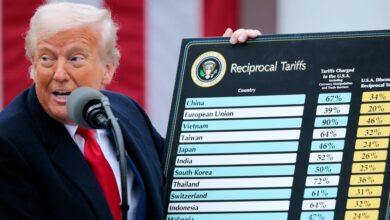US economy shrinks as firms import more ahead of tariffs

The United States economy experienced a contraction in the first quarter of the year, with government spending decreasing and imports surging as businesses rushed to bring goods into the country ahead of tariffs. According to the Commerce Department, the economy shrank at an annual rate of 0.3%, a significant drop from the 2.4% growth in the previous quarter. This marked the first quarterly decline in three years and was attributed to the uncertainty created by President Donald Trump’s implementation of import taxes.
Analysts cautioned that it would take time to fully understand the impact of these tariff changes. While imports negatively impacted the calculation of gross domestic product (GDP), it is expected that this surge will be reversed in the coming months. Despite the downturn in the economy, consumer spending, which is a key driver of the US economy, expanded by 1.8%, although at a slower pace than in the previous year.
During a television appearance with cabinet members, President Trump shifted blame to his predecessor, Joe Biden, for the economic weakening, asserting that his policies would lead to increased investment in the US and spur economic growth. He downplayed concerns about potential price increases, supply shocks, and shortages resulting from the decline in trade between the US and China.
The White House issued a statement characterizing the GDP figures as a "backward-looking indicator" and emphasized the strong momentum that President Trump was delivering through his policies. Since taking office earlier in the year, Trump has implemented a series of new trade tariffs aimed at generating revenue for the government and revitalizing US manufacturing.
The report tracked economic activity through the end of March, prior to the announcement of far-reaching tariffs on China and other countries. Importantly, it showed a significant increase in imports and a slight slowdown in consumer spending compared to the previous quarter. Business investment unexpectedly rose, while final sales to private domestic purchasers remained relatively stable.
Economists warned that tariffs could lead to higher prices, prompting some companies to announce price hikes in response. The uncertainty surrounding trade policies has made it challenging for companies to provide sales forecasts, with many opting to withhold guidance. Stock indexes initially dipped following the release of the GDP figures but ultimately ended the day flat.
Despite the contraction in GDP, economists at Wells Fargo noted that the US economy is at a greater risk of recession than before, but the recent downturn is not indicative of an imminent recession. The drag on growth from trade was the most significant since the 1940s, underscoring the potential challenges ahead.
In conclusion, the US economy faces uncertainty and potential risks due to trade policies and tariff implementations. While the recent GDP contraction is concerning, it is not necessarily a sign of an impending recession. Continued monitoring and analysis of economic indicators will be crucial in navigating the evolving economic landscape.
Additional reporting by Bernd Debusmann Jr at the White House





